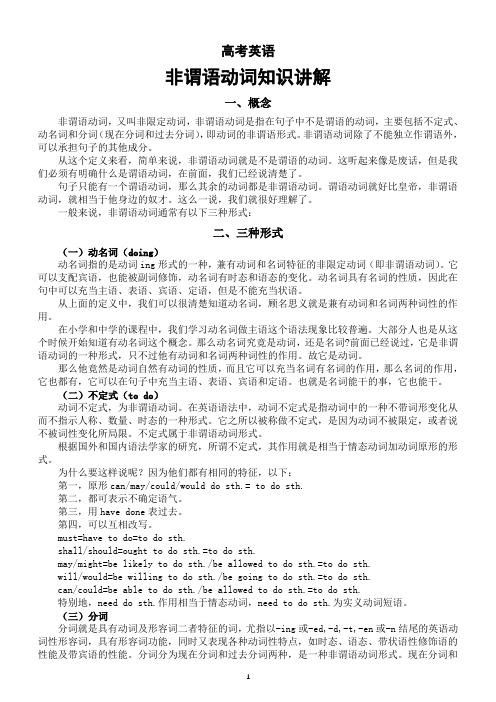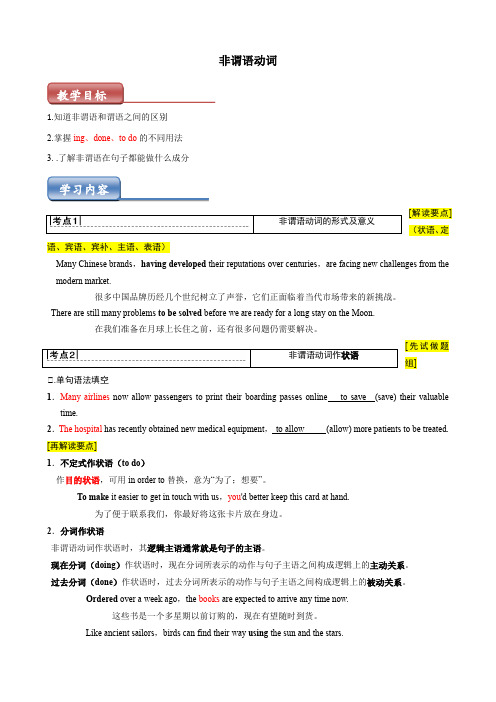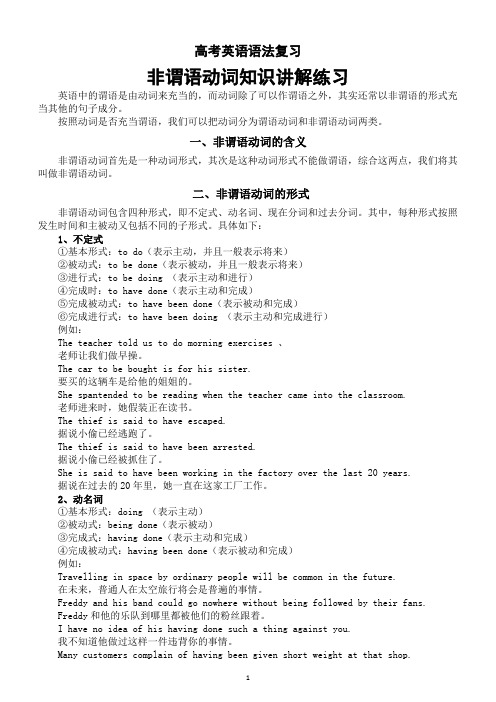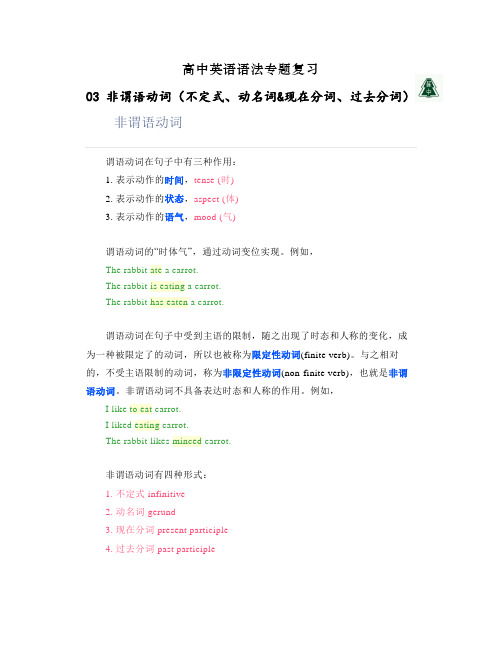高三英语语法-非谓语动词复习
高考英语二轮总复习 核心语法必备 专题二 非谓语动词

重点一
重点二
重点三
重点四
重点五
(2)表示 “使, 让” 的动词, 如make/let/have/get/keep/leave+宾语+补语
Father advised me to
say something. 父亲建议我说点什么。
常用动词不定式做主语补足语的句型有sb/sth be He is said to have been
said/believed/known/reported/considered/thought found in the street.
形式 用法
示例
现在分词
表示动作 正在进行
boilingwater 正沸腾的水 boiledwater 白开水
fallingleaves 正在下落的叶子
过去分词
表示动作 已经完成
fallenleaves 落叶 developingcountries 发展中国家 developedcountries 发达国家
重点一
重点二
重点三
重点四
重点五
提示
(1)某些过去分词(短语)已经形容词化, 它们既不表示被动, 也不表示完成,
而表示一种状态, 如lost, seated, hidden, lost/absorbed in, dressed in, tired of
等。
Absorbed in the book, he didn't notice me enter the room.
高考英语语法考点复习课件-非谓语动词(强力推荐)

qualification for the job.
Jack's suddenly disappearing made them worried.
熟 读 深思 2. 不定式、动名词和分词作表语
(1) What I would suggest is to start work at once.
(2) His hobby is collecting stamps.
熟 读 深思 1. 不定式和动名词作主语 It is not very good for you to smoke so much.
Climbing mountains is interesting.
is no use/good crying. 规则 1:动名词作主语通常表示抽象动作, 而不定
式作主语表示具体动作。
动词不定 动名词 现在分词 过去分 doing doing 式 to do 词 done to do doing doing done to be done being being 无 done(被 done(正在 ……) 被……) 形 having having 主动完成式 to have 无 式 done done done having having 被动完成式 to have 无 been done been been done done 否定式 在上述各种非谓语动词形式之前直接加not
归 纳 总结
规则4:get, become, look, seem, appear, remain等系动词 后都可跟 done ,表示被动或主语的状态 。如 remain seated/hidden, get paid/dressed/changed /stuck/hurt/injured/burnt等。19,97 What the workers have been told is that they get paid by the hour. 常用be done+介词短语表示所处的状态,如下: be addicted to…沉迷于……/ be absorbed in…全神贯注 于…… be aimed at…旨在/意图…… be armed with…有……装备 be buried in…埋葬在……
高中英语高考复习非谓语动词知识讲解

高考英语非谓语动词知识讲解一、概念非谓语动词,又叫非限定动词,非谓语动词是指在句子中不是谓语的动词,主要包括不定式、动名词和分词(现在分词和过去分词),即动词的非谓语形式。
非谓语动词除了不能独立作谓语外,可以承担句子的其他成分。
从这个定义来看,简单来说,非谓语动词就是不是谓语的动词。
这听起来像是废话,但是我们必须有明确什么是谓语动词,在前面,我们已经说清楚了。
句子只能有一个谓语动词,那么其余的动词都是非谓语动词。
谓语动词就好比皇帝,非谓语动词,就相当于他身边的奴才。
这么一说,我们就很好理解了。
一般来说,非谓语动词通常有以下三种形式:二、三种形式(一)动名词(doing)动名词指的是动词ing形式的一种,兼有动词和名词特征的非限定动词(即非谓语动词)。
它可以支配宾语,也能被副词修饰,动名词有时态和语态的变化。
动名词具有名词的性质,因此在句中可以充当主语、表语、宾语、定语,但是不能充当状语。
从上面的定义中,我们可以很清楚知道动名词,顾名思义就是兼有动词和名词两种词性的作用。
在小学和中学的课程中,我们学习动名词做主语这个语法现象比较普遍。
大部分人也是从这个时候开始知道有动名词这个概念。
那么动名词究竟是动词,还是名词?前面已经说过,它是非谓语动词的一种形式,只不过他有动词和名词两种词性的作用。
故它是动词。
那么他竟然是动词自然有动词的性质,而且它可以充当名词有名词的作用,那么名词的作用,它也都有,它可以在句子中充当主语、表语、宾语和定语。
也就是名词能干的事,它也能干。
(二)不定式(to do)动词不定式,为非谓语动词。
在英语语法中,动词不定式是指动词中的一种不带词形变化从而不指示人称、数量、时态的一种形式。
它之所以被称做不定式,是因为动词不被限定,或者说不被词性变化所局限。
不定式属于非谓语动词形式。
根据国外和国内语法学家的研究,所谓不定式,其作用就是相当于情态动词加动词原形的形式。
为什么要这样说呢?因为他们都有相同的特征,以下:第一,原形can/may/could/would do sth.= to do sth.第二,都可表示不确定语气。
非谓语动词 高考英语考点-语法-词汇复习资料

七、非谓语动词非谓语动词的语法功能注:现在分词、不定式、过去分词都可以作独立成分generally speaking一般说来;frankly speaking坦白地说;judging from/by...根据……来判断;considering.../taking...into consideration考虑到……;to tell you the truth说实话;seeing...考虑到……;supposing假设,如果;providing如果;given考虑到,鉴于;provided that如果非谓语动词的形式变化在解非谓语习题时同学们遇到最大的困难有两个:一是如何判别是谓语动词还是非谓语动词;二是如何选用哪一种非谓语动词及其恰当的形式。
一、谓语与非谓语的比较非谓语动词是汉语中没有的语言现象。
汉语中几个谓语动词连用而动词不用作任何形式的变化。
如:他明天来拜访你。
翻译成英语不是He will come visit you,而是He will come to visit you.这里就用了不定式to visit。
因此同学们要特别注意弄清句子的结构。
例:Tom sat under a tree and seeing his friend, up in no time.A. to standB. standingC. stoodD. would stand分析:stood是与sat并列的谓语。
非谓语语法功能的比较做宾语的非谓语动词比较非谓语动词做宾语补足语的区别IV. 非谓语动词做定语的区别注意:the bridge to be built 将建造的桥, the bridge being built 正在建造的桥,the bridge built已经建好的桥。
高中英语一轮复习非谓语动词讲义

非谓语动词 1.知道非谓语和谓语之间的区别2.掌握ing 、done 、to do 的不同用法3. .了解非谓语在句子都能做什么成分 [解读要点](状语、定语、宾语、宾补、主语、表语)Many Chinese brands ,having developed their reputations over centuries ,are facing new challenges from the modern market.很多中国品牌历经几个世纪树立了声誉,它们正面临着当代市场带来的新挑战。
There are still many problems to be solved before we are ready for a long stay on the Moon.在我们准备在月球上长住之前,还有很多问题仍需要解决。
[先试做题组]Ⅰ.单句语法填空1.Many airlines now allow passengers to print their boarding passes online to save (save) their valuable time.2.The hospital has recently obtained new medical equipment , to allow (allow) more patients to be treated.[再解读要点]1.不定式作状语(to do )作目的状语,可用in order to 替换,意为“为了;想要”。
To make it easier to get in touch with us ,you 'd better keep this card at hand.为了便于联系我们,你最好将这张卡片放在身边。
2.分词作状语非谓语动词作状语时,其逻辑主语通常就是句子的主语。
现在分词(doing )作状语时,现在分词所表示的动作与句子主语之间构成逻辑上的主动关系。
高中英语2025届高考语法复习非谓语动词知识讲解练习

高考英语语法复习非谓语动词知识讲解练习英语中的谓语是由动词来充当的,而动词除了可以作谓语之外,其实还常以非谓语的形式充当其他的句子成分。
按照动词是否充当谓语,我们可以把动词分为谓语动词和非谓语动词两类。
一、非谓语动词的含义非谓语动词首先是一种动词形式,其次是这种动词形式不能做谓语,综合这两点,我们将其叫做非谓语动词。
二、非谓语动词的形式非谓语动词包含四种形式,即不定式、动名词、现在分词和过去分词。
其中,每种形式按照发生时间和主被动又包括不同的子形式。
具体如下:1、不定式①基本形式:to do(表示主动,并且一般表示将来)②被动式:to be done(表示被动,并且一般表示将来)③进行式:to be doing (表示主动和进行)④完成时:to have done(表示主动和完成)⑤完成被动式:to have been done(表示被动和完成)⑥完成进行式:to have been doing (表示主动和完成进行)例如:The teacher told us to do morning exercises 、老师让我们做早操。
The car to be bought is for his sister.要买的这辆车是给他的姐姐的。
She spantended to be reading when the teacher came into the classroom.老师进来时,她假装正在读书。
The thief is said to have escaped.据说小偷已经逃跑了。
The thief is said to have been arrested.据说小偷已经被抓住了。
She is said to have been working in the factory over the last 20 years.据说在过去的20年里,她一直在这家工厂工作。
2、动名词①基本形式:doing (表示主动)②被动式:being done(表示被动)③完成式:having done(表示主动和完成)④完成被动式:having been done(表示被动和完成)例如:Travelling in space by ordinary people will be common in the future.在未来,普通人在太空旅行将会是普遍的事情。
语法非谓语动词复习课件-2023届高三英语一轮复习

完成式
To have done
She pretended to have read the novel.(表示主动)
To have been done
不要看到done就很激动,认为 有done就是被动语态,be和 done同时存在才表示被动。
完成式表示不定式动作发生在谓 语动作之前。
Sb/sth be seen to do 变为被动补充to(某人被看 见做······)
I see her singing the song. 我看到她正在唱歌。 She is seen singing the song by me.
I see the song sang be her. 看到那首歌被他唱。 I see him beaten. 看到他被打。
用法
例句
说明
补足语 We all found his
作宾补的现在分词与宾
(宾补; argument convincing 语逻辑上是主动关系,
主补) and interesting.
表示宾语的性质或状态。
I heard Tom arguing 还是那些词,经常接宾 with someone else. 补的词
不定式的基本形式:to do 不定式的否定形式:not to do
注意:to还可能是一个介词, 当to是介词时,后面接ing 形式。
To doing To do
To后接doing To后接动词原形
To是介词
To是非谓语不定 式的一部分
不定式的时态和语态
语态 时态
主动语态
一般式
To do
不定H式e的pr一et般en式d表ed示not to see us.
高考英语语法专题复习:非谓语动词讲义(不定式、动名词

高中英语语法专题复习03 非谓语动词(不定式、动名词&现在分词、过去分词)非谓语动词谓语动词在句子中有三种作用:1. 表示动作的时间,tense (时)2. 表示动作的状态,aspect (体)3. 表示动作的语气,mood (气)谓语动词的“时体气”,通过动词变位实现。
例如,The rabbit ate a carrot.The rabbit is eating a carrot.The rabbit has eaten a carrot.谓语动词在句子中受到主语的限制,随之出现了时态和人称的变化,成为一种被限定了的动词,所以也被称为限定性动词(finite verb)。
与之相对的,不受主语限制的动词,称为非限定性动词(non-finite verb),也就是非谓语动词。
非谓语动词不具备表达时态和人称的作用。
例如,I like to eat carrot.I liked eating carrot.The rabbit likes minced carrot.非谓语动词有四种形式:1. 不定式 infinitive2. 动名词 gerund3. 现在分词 present participle4. 过去分词 past participle谓语动词是简单句的核心动词,非谓语动词只可能出现在其他的句子成分中。
1. 主语例:Swimming makes us hale and hearty.2. 宾语例:Janet suddenly stopped talking.3. 表语/主语补语例:Her wish is to become a doctor in the future.4. 宾语补语例:I invited him to come here.5. 定语例:Don't disturb the sleeping dog.6. 状语例:He went to the supermarket to buy a pen.不定式、动名词句子的核心动词只能由谓语动词充当,而非谓语动词可以充当句子的其他成分。
非谓语动词(doingdone)课件高考英语一轮语法复习

• The young man sitting between John and Mary is the editor of the campus newspaper.
The young man who is sitting between John and Mary is ......
动名词
doing
现在分词
主动
被动 (be done)
意义
一般式
doing being done
完成式 (have done)
having
done
having been done
同时发生
● Someone saw him entering the room from the back door at that time.
① It is useless/no use/no good/no harm + doing sth.
做某事没有用处/好处/坏处
② It is a waste of time + doing sth. 做某事是一件浪费
时间的事。
③ It is worthwhile + doing sth. 做某事是值得的
to 在下列短语中是介词,常跟动名词作宾语。
be/get used to
look forward to
get down to
pay attention to
devote oneself to contribute to
...
lead to object to(反对)
Let’s get down to preparing for the exam.
常考点非谓语动词课件高考英语总复习

非谓语动词的分类
动词不定式(to do):表示动作的 未完成或未开始
动名词(doing): 表示动作的进行或 状态
分词(done/doing ):表示动作的完 成或被动
独立主格结构:由名 词/代词+非谓语动词 构成,表示原因、条 件、时间等关系
非谓语动词的用法
非谓语动词包括动名词、不定式和分词三种形式
非谓语动词在句子中不充当谓语,但可以充当其他成分,如主语、宾语、定语、状语 等
非谓语动词可以表示动作的状态、方式、原因、结果等
非谓语动词可以与其他词类或结构搭配使用,如介词短语、从句等
03
非谓语动词的时态和语态
非谓语动词的时态
非谓语动词的时态包括:一般 式、进行式、完成式和完成进 行式
一般式表示非谓语动词的动作 与主句的动作同时发生或发生 在主句动作之前
非谓语动词的解析方法和技巧
非谓语动词的定义和分类 非谓语动词的语法功能和用法 非谓语动词的时态和语态 非谓语动词的句法结构和翻译技巧 非谓语动词的常见错误和解决方法 非谓语动词的练习题和解析
06
非谓语动词在高考英语中 的运用
高考英语中非谓语动词的常考题型
非谓语动词的基本 概念和分类
非谓语动词的时态 和语态
常考点非谓语动词 课件高考英语总复 习
汇报人:
目录
01 单 击 添 加 目 录 项 标 题 02 非 谓 语 动 词 的 概 述
03 04 非 谓 语 动 词 的 时 态 和 语态
非谓语动词的特殊用 法
05 06 非 谓 语 动 词 的 练 习 和 解析
非谓语动词在高考英 语中的运用
01
添加章节标题
非谓语动词的填空题练习
a. 动词不定式填空题 b. 动名词填空题 c. 分词填空题 d. 独立主格结构填空题
高中英语语法复习——非谓语动词在语法填空中应用 优质课件(33张PPT)

原主则句五 主原:语则非 保谓 持五语 一:动 致非词 。谓作语状动语词时,作原状则语上时其,逻…辑主语应与 原原则则六:六强:调强动调作动发作生发在生主句在谓主语句动谓作语之动前作,原则上 要用完成式(-ing之的前完时成,式或…不定式的完成式)
原则七:用于名词后作定语,原则是:不定式表示动作
__m__a________ (make) it the most popular sport
in the world.
分词表示结果包含着一种必然发生的结果。
• 非谓语动词考点语篇填空综合应用
Exercise 1
• We are ____1___ (interest) in the story about Sn ow White because it is a very _______2_______ ( interest) story. Once upon a time, there was a pri ncess __3___ (name) Snow White. She was the m ost beautiful girl in the world but she had a step mother who treated her very badly. She even ord ered a guard to kill her. The guard didn’t kill Sno w White. Instead, he asked Snow White to escape at once. ___4___ (terrify) by some strange sound s, she ran quickly through the forest and came to a wooden house
高三英语语法复习 非谓语动词

高三英语非谓语动词不定式(infinitive)、分词(participle)、动名词(gerund)是非谓语动词,在句中不能作谓语。
一、非谓语动词作主语可作主语的非谓语动词是不定式和动名词。
例1 To act like that is foolish.例2 Walking is good exercise.例3 ---Why were you so late for work today ?---Driving to the office was very slow this morning because of the traffic.一般说来,动名词与不定式作主语时,可以互换,注意:1)表示具体的,尤其是未发生的动作,倾向用不定式(例1),表示无时限的泛指动作(例2),或描述当时的情况(例3)倾向用动名词。
2)下列句型用动名词作主语:It is no good(use) arguing with you.There is no knowing what may happen.(不可能知道将会发生什么。
)二、非谓语动词作表语可作表语的非谓语动词是不定式、动名词和分词。
My idea is to climb the mountain from the north.(不定式解释主语内容)My favorite sport is playing football.(动名词解释主语内容)His speech is inspiring.(分词说明主语性质)The person was moved by the story.动名词和不定式作表语时,一般也无严格区别,但在表语是不定式的句子中,若主语也用非谓语形式,这时要用不定式;同样表语是动名词时,则主语要用动名词。
To see is to believe.Reading is learning,but applying(运用)is also learning and more important kind of learning.三、非谓语动词作宾语可作宾语的非谓语动词是不定式和动名词。
高考英语非谓语知识点

高考英语非谓语知识点非谓语动词在高考英语中占据着重要的位置,对于考生来说掌握非谓语知识点不仅有助于理解语法结构,还可以提高语言表达的准确性和多样性。
本文将就高考英语非谓语知识点进行介绍和讨论。
一、动词不定式(Infinitive):动词不定式可以用作主语、宾语、定语、表语和状语等的句子成分。
常见的动词不定式有to do。
例如:1. 主语:To read good books is beneficial to our knowledge and growth.阅读好书对我们的知识和成长有益。
2. 宾语:She likes to listen to music in her spare time.她喜欢在闲暇时间听音乐。
3. 定语:I need a pen to write down the notes.我需要一支笔来记下笔记。
4. 表语:Her dream is to become a successful lawyer.她的梦想是成为一名成功的律师。
5. 状语:To pass the exam, you need to study hard.为了通过考试,你需要努力学习。
二、动名词(Gerund):动名词以-ing 结尾,可以用作主语、宾语、定语和状语等的句子成分。
常见的动名词有doing。
例如:1. 主语:Reading is my favorite hobby.阅读是我最喜欢的爱好。
2. 宾语:I enjoy swimming in the sea.我喜欢在海里游泳。
3. 定语:I saw a girl singing on the stage.我看到一个女孩在舞台上唱歌。
4. 状语:He went to bed early, hoping to wake up refreshed the next day.他早早上床睡觉,希望第二天早上精力充沛。
三、动词现在分词(Present Participle):动词现在分词以-ing 结尾,可以用作定语和状语等的句子成分。
- 1、下载文档前请自行甄别文档内容的完整性,平台不提供额外的编辑、内容补充、找答案等附加服务。
- 2、"仅部分预览"的文档,不可在线预览部分如存在完整性等问题,可反馈申请退款(可完整预览的文档不适用该条件!)。
- 3、如文档侵犯您的权益,请联系客服反馈,我们会尽快为您处理(人工客服工作时间:9:00-18:30)。
高三英语语法-非谓语动词复习不定式(infinitive)、分词(participle)、动名词(gerund)是非谓语动词,在句子中不能作谓语.........。
以下表格列出了他们各自在句中的作用。
(√表示可以在句中担任的语法成分,×则表示不可以。
)非谓语动词在句中的特点、性质、用法、区别及使用注意事项分述如下:第一节、非谓语动词作主语可作主语的非谓语形式为:不定式和动名词。
其表达形式为:不定式:主动态to do; 被动态to be done; 动名词:主动态doing; 被动态being done。
例1:To act like that is foolish.例2:It is impossible for me to buy the car with cash. 要我用现金买那辆车是不可能的。
例3:Walking is a good form of exercise for both young and old.例4:——What made you so late for work today ?——Driving to the office was very slow this morning because of heavy traffic.因为交通拥挤,今早开车上班非常慢。
一般说来,动名词和不定式作主语,可以互换,其意义没有多大差别,但须注意以下两点:1.表示具体的,尤其是未发生的动作,倾向用不定式(如例2)。
表示无时限的泛指动作(如例3)或描述当时的情况(如例4),倾向用动名词。
2.在下列句型用动名词作主语It is no good doing.(……没有用)There is no doing. (……不可能)It is no good arguing with him. 和他争论没有用。
There is no knowing what may happen. = It is impossible to know what may happen.练习:1.(改错)As is known, learn a foreign language well requires great efforts.2.(改错)Though flying balloons are easy, balloonists must watch the weather carefully.3.(选择)_______ to sunlight for too much will do harm to one’s skin.A. Exposed toB. ExposingC. Having exposedD. Being exposed答案:1.learn → learning 原形动词不能作主语。
2.are → is 单个动名词作主语,谓语用单数。
3.答案D。
句义:遭太阳暴晒对皮肤有害。
本题考查动名词作主语。
分析句子结构可知,待选项在句中作主语,又因为人与expose为被动关系,所以选D。
第二节、非谓语动词作表语可作表语的非谓语动词为:不定式,动名词。
1.Your task this morning is to deliver the mail to Professor Smith. 你今天上午的任务是把这个邮件送给史密斯教授。
(不定式解释主语内容)2.My hobby is collecting stamps. (动名词解释主语内容)1. The purpose of new technologies is to make life easier, ____it moredifficult.(99全国)A. not make B. not to make C. not makingD. do not make2.分析句子是否正确: What we do is prepare our students to facefierce competitions when they enter society.1、答案B。
is后有两个表语,两者必须在结构上对称。
第一个表语为不定式to make life easier,则第二个表语也应该为不定式,所以选B。
2、正确。
当主语部分有实义动词do 时,作表语的不定式可以省略to; 若没有实义动词do,表语中to不能省略。
第三节、非谓语动词作宾语可作宾语的非谓语动词为:不定式和动名词。
1.不定式作宾语例1.He demanded to know the truth.例2.The car failed to stop at the red light. 那辆轿车看到红灯没有停。
英语中有相当数量的动词,只能以不定式作宾语。
如:agree(同意),decide, refuse, pretend(假装),manage(设法),promise, seem, happen, hope, wish, offer to do(表示愿望)afford to do(买得起,承担得起),bother to do(特意),choose to do(愿意或决定)attempt / seek to do(试图)learn to do(学习或学会)短语would like(love)to do,would prefer to do(更愿意),be about to do(即将),介词but / except to do例1)I have no choice but to give up the plan.2)There was nothing we could do except wait.注:but / except前有实义动词do, 其后to必须省去请注意以下几点:1)疑问代词如what,which;疑问副词如when, whether(why除外)引导的不定式可作know, decide等的宾语,在意义上相当与一个未曾发生的宾语从句。
例1.We haven’t decided what steps to take next.→We haven’t decided what steps we should take next.2.I really don’t know whether to write to her or give her a phone call.→I really don’t know whether I should write to her or give her a phone call.这种结构也可以作主语和表语例1.What to do next remains to be discussed. 下一步该怎么办有待于讨论。
例2.Our difficulty is where to get enough money.2)为了避免重复,不定式可省去与前边重复的动词原形,而保留“to”。
例:——Would you like to go for a picnic with me ?——I’d love to, but I can’t spare any time at present.(to后省略了go for a picnic with you)不定式的进行时和完成时常用在下列句型中:seem / appear(似乎)to1)S(人,物)happen(碰巧)topretend tobe said(据说)tobe thought / supposed / considered/ believed(据认为)to2)S(人,物)be reported(据报导)tobe known(知道)to请注意:考查不定式的时态和语态,主要集中在以上句型中,是高考的重点和热点。
I happened to be standing next to him when he fell down.The bank is reported in the local newspaper to have been robbed in broad daylight yesterday. 据当地报纸指导,这家银行昨天在光天化日之下遭到抢劫。
He is known to have been arrested by the police. 人们都知道他曾被警察逮捕过。
4)was / were to have done ;would like to have donewished(hoped / wanted / intended / meant)to have done表示当时想做,而实际不能做到I was to have picked you up at the airport, but I forgot about it.I intended to have helped you out but I had no money then. 我当时真想帮助你摆脱困境,可是我那时身无分文。
2.动名词作动词或介词的宾语I can’t imagine marrying a girl of that sort. 我很难想象与那种女子结婚后的情形。
I narrowly missed being killed in the car accident. 在那次车祸中我死里逃生。
He admitted having stolen my bicycle. 他承认偷了我的自行车。
There is no point in arguing any further.再争议下去毫无意义。
1)下列动词必须带动名词结构作宾语:understand(理解),admit(承认),keep(on)(继续),practise (练习),finish(完成),imagine(想象),miss(错过,避免),avoid(避免),escape(逃避),suggest(建议),dislike(讨厌),enjoy(喜欢),delay(推迟),excuse(原谅),mind(介意),appreciate(感激),oppose(反对)。
另外,有的词既可带动名词做宾语,亦可带不定式做宾语补足语,请区别清楚。
如:allow doing(比较:allow sb. to do)advise doing(比较:advise sb. to do)2)下列短语必须带动名词结构作宾语:be worth(值得),pay attention to(注意),object to(反对),can’t help(情不自禁),devote oneself to(致力于),put off(推迟),be / get used to(习惯于),feel like(想要),look forward to(盼望),get down to(开始做,认真做某事),how / what about(……怎么样),There is no point (in) doing sth (做某事毫无意义)3)下列动词可以用不定式作宾语,也可以用动名词作宾语,但有明显的语义差别。
